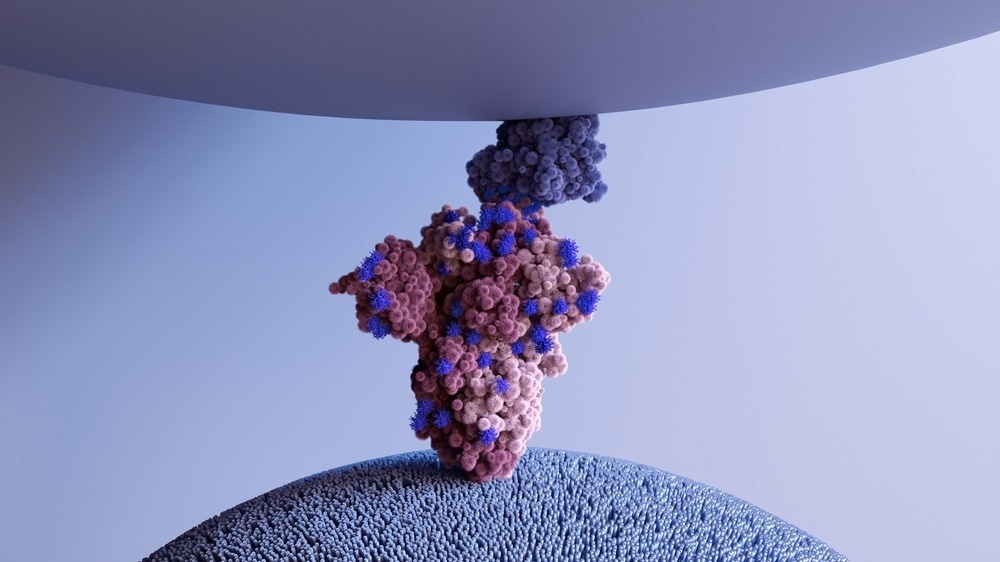A recent iScience journal study reports that cell-surface vimentin functions as a co-receptor for the entry of the severe acute respiratory syndrome coronavirus 2 (SARS-CoV-2) into host cells to facilitate infection. Thus, targeting vimentin may provide a unique strategy for preventing the coronavirus disease 2019 (COVID-19).

Study: Vimentin is an important ACE2 co-receptor for SARS-COV-2 in epithelial cells. Image Credit: Design_Cells / Shutterstock.com
Background
The emergence and rapid spread of SARS-CoV-2 have significantly impacted global health and the economy. As of November 2, 2022, SARS-CoV-2 has infected over 636 million worldwide and claimed more than 6.59 million lives.
The entry of SARS-CoV-2, which is a single-stranded enveloped ribonucleic acid (RNA) virus), into host cells is a key factor for its infectivity and disease pathogenesis. To this end, SARS-CoV-2 primarily relies on its receptor binding domain (RBD) within the spike protein to bind to the cell-surface angiotensin-converting enzyme 2 (ACE2) receptor for viral attachment. This subsequently allows the virus to enter endosomes and fuse with host-lysosomal membranes.
Although COVID-19 primarily causes respiratory symptoms, ACE2 is sparsely expressed throughout the respiratory tract. This suggests that additional cofactors may compensate and enable the spike protein and host receptor interactions.
Vimentin is a type III intermediate filament cytoskeletal protein expressed within and on the surface of various types including fibroblasts, endothelial cells, macrophages, melanocytes, Schwann cells, and lymphocytes. More recently, researchers have reported that vimentin appears to interact with the SARS-CoV-2 spike protein.
About the study
In the current study, the researchers used a variety of epithelial cell lines, including Vero E6, human colon epithelial cells (Caco-2), and human alveolar basal epithelial cells (A549), to determine the expression of ACE2, TMPRSS288, and vimentin. In the next step, the researchers assessed whether vimentin and ACE2 expression levels in Vero E6, Caco-2, and A549 cells were related to the entry of SARS-CoV-2 into cells.
The researchers also examined whether viral infection altered vimentin expression on the cell surface. Using Western blot analysis following SARS-CoV-2 infection, vimentin in the cell supernatant was assessed for co-localization with SARS-CoV-2.
Vimentin was also evaluated for its ability to inhibit viral infection by pre-treating cells for 30 minutes with withaferin A (WFA), which is a steroidal lactone that binds and causes vimentin aggregation in vitro. Quantitative polymerase chain reaction (qPCR) assay was used to quantify vimentin aggregation, whereas immunofluorescence and confocal microscopy provided visualization of this process.
Study findings
Epithelial cells were found to express varying quantities of vimentin and ACE2. Vero E6 cells, for example, expressed higher levels of ACE2 as compared to Caco-2 and A549 cells. Conversely, both Vero E6 and Caco-2 cells expressed similar levels of TMPRSS2 that were significantly higher than the expression of this cell surface protein in A549 cells.
Vimentin was expressed at very low levels in Caco-2 cells as compared to Vero E6 and A549 cells. Notably, Vero E6 cells exhibited a higher level of vimentin expression as compared to A549 cells; however, cell surface expression of vimentin was highest in A549 cells.
Following infection with SARS-CoV-2, viral uptake in Vero E6 levels was greatest between ten minutes and two hours. Although SARS-CoV-2 uptake was similarly high in Caco-2 cells at ten minutes, these levels did not rise over the course of two hours. The uptake of SARS-CoV-2 was much less in A549 cells.
Taken together, these findings suggest that the expression of vimentin at the cell surface may favor the increased uptake of SARS-CoV-2 in Vero E6 cells as compared to the other epithelial cell lines. Further analysis of SARS-CoV-2 infection in Vero E6 cells revealed that vimentin expression increased at the cell surface after two and thirty minutes.
Meanwhile, there was no interaction between vimentin and ACE2 in uninfected Vero E6 cells, thus indicating that vimentin may function as a co-receptor for SARS-CoV-2 infection.
Pre-treatment with WFA prior to SARS-CoV-2 infection in Vero E6 cells did not significantly impact viral replication in cells. These findings demonstrate that although vimentin promotes SARS-CoV-2 cell infection, it is not essential for viral replication in cells.
Nevertheless, pre-treatment with WFA reduced cell death in SARS-CoV-2 infected cells, thus suggesting that the inhibition of vimentin may reduce the likelihood of virus-induced cell death. Furthermore, pre-treatment with anti-vimentin reduced the expression of interleukin 6 (IL-6) by 15-fold, as well as CCL5 and CSCL10 by 10-fold, thus indicating that the inhibition of vimentin may also limit the inflammatory response to SARS-CoV-2 infection.
Notably, when these experiments were repeated with the SARS-CoV-2 Omicron variant, similar results were observed. Thus, mutations within the Omicron spike protein do not appear to impact the interaction between SARS-CoV-2 and vimentin during infection.
Journal reference:
- Arrindell, J., Abou Atmeh, P., Jayet, L., et al. (2022). Vimentin is an important ACE2 co-receptor for SARS-COV-2 in epithelial cells. IScience. doi:10.1016/j.isci.2022.105463